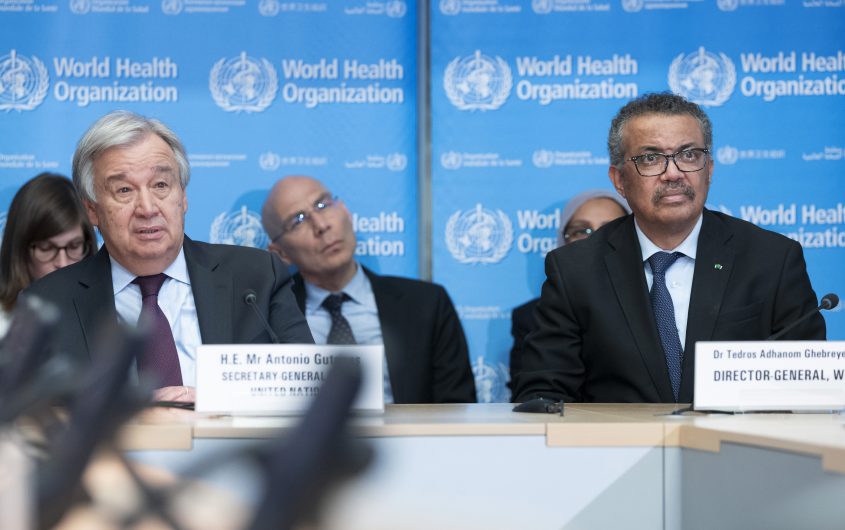
UN Geneva via Flickr
Transatlantic Pandemic Response Shortcomings Highlight Need for More Robust Public Health Communications Infrastructure

Marjorie K. Connolly
Marjorie K. Connolly is an independent public health communications consultant who works with the Infectious Diseases Society of America on COVID-19 response. She studies global history at the Humboldt and Freie Universities of Berlin, where she focuses on the conceptual history of universal health care. As a 2018-2019 Robert Bosch Foundation Transatlantic Fellow she conducted research comparing the German and American health systems. Her career in American health policy has included roles on Capitol Hill and as spokeswoman for the U.S. Department of Health and Human Services during the Obama administration.
As we enter May 2022, both the United States and Germany have reached similar inflection points in the ongoing COVID-19 pandemic. Highly effective vaccines and boosters are widely available to most residents over age five. Newly-available medications have the potential to mitigate disease severity as well as to provide pre-exposure prophylaxis for people at higher risk of severe disease. Yet takeup of booster shots and new medications is low; compliance with masking rules and recommendations has waned; and many of the public want to “move on” from the crisis phase of a grueling global pandemic that has now entered its third year.
As of late April 2022, only 25 percent of Germans were satisfied with their federal government’s handling of the pandemic compared with 61 percent who were dissatisfied; overall, national satisfaction levels have been underwater since January 2021, according to Civey data.[1] When asked which aspects of the German federal response have been least satisfying, the top two answers were clear presentation of data (31.1 percent) and crisis communications (21.8 percent).[2]
U.S. polling paints a similar picture of popular frustration with the quality of public health communication during the pandemic thus far. Approval ratings for local, state, and federal handling of the pandemic had fallen by February 2022 compared to a year earlier, according to Pew Research Center data, with the sharpest drop in approval for CDC and other public health officials.[3] 60 percent of poll respondents reported confusion about changing public health recommendations, while 57 percent said the changes made them wonder whether officials were holding back important information.[4]
Effective communication and engagement between a government and its citizens play a central role in any healthy democracy. During the pandemic, public health communication has been placed at the center of those conversations—and too often, has been found lacking.
It should worry us to see such low satisfaction with national public health communication, especially in this moment of the pandemic. There is an urgent need to inform health care workers and the public about the availability of new treatments that can save lives and prevent severe illness, especially among high-risk populations that have the most to gain from these advances. There is a continuing need to discuss the various paths the pandemic could take from here and how we should plan for those contingencies. And there is a constantly growing need to acknowledge and grieve the enormous suffering and loss that both our countries have faced.
Many analysts have depicted the COVID-19 pandemic as a “stress test” for health care systems and political systems. In both Germany and the United States, COVID-19 has stress-tested not only our political institutions but also our ability to inform the public. Effective communication and engagement between a government and its citizens play a central role in any healthy democracy. During the pandemic, public health communication has been placed at the center of those conversations—and too often, has been found lacking.
Public health communications practitioners should take this feedback seriously, as should supporters of vibrant democracies. And it is a criticism that should not be limited to the relationship between national governments and citizens. International organizations such as the United Nations and its World Health Organization have also played a key role in shaping public health communication throughout the pandemic.
As two of the world’s most muscular defenders of the liberal democratic ideals and the international system that the UN and WHO represent, the United States and Germany have a strong interest in communicating to the governments and citizens of the world that these agencies are responsive and effective in performing their most important job: holding the world together in a crisis. And as two of the world’s leading hubs for medical innovation and creators of the most highly effective COVID-19 vaccines and treatments to date, the world has looked to the United States and Germany to show moral leadership in the planetary effort to respond to COVID-19. But so far, that opportunity has been missed.
An agenda toward building a more robust public health communications infrastructure would involve collecting and formalizing this knowledge and supporting international collaboration to elevate public health communication as a distinct and valuable professional discipline.
Globally, COVID-19 cases and deaths continue to follow a steady trend upwards, indicating a pandemic that remains out of control. However, the global COVAX vaccination campaign that relies on donations from countries like the United States and Germany is failing to reach its goals. If current rates of first-dose administration are maintained throughout this year, the average level of COVID-19 vaccination in low-income countries’ populations will remain flat at 14 percent, leaving progress towards vaccinating the world completely stalled and making the UNGA/WHO goal of 70 percent vaccination in 2022 little more than a fantasy.[5] And as effective new treatments emerge, there is even less momentum behind ensuring global equity in access.
What message does this failure send to world leaders and citizens about the quality and sustainability of our international system? In a time of resurgent authoritarianism and right-wing populism where the future of the international order seems more plastic than ever before, the champions of liberal internationalism have a strong interest in making an affirmative case for the benefits of the UN and its member institutions. But over the course of 2021, as the UN, WHO, and major liberal democracies like the United States and Germany ceded the field on vaccine distribution, bilateral vaccine diplomacy efforts by countries including China and Russia sought to fill the gap.[6]
In both national and international contexts, the effective functioning of democratic institutions relies on high-quality public health communication that accompanies and supports high-quality public health interventions. The need for such communication competencies is laid bare in crisis contexts like a pandemic. And the tools to communicate effectively in the context of a pandemic or a vaccination campaign are no mystery—there is a wealth of research and experience to draw from.
An agenda toward building a more robust public health communications infrastructure would involve collecting and formalizing this knowledge and supporting international collaboration to elevate public health communication as a distinct and valuable professional discipline. Doing so will not only improve our preparedness to respond to the ongoing COVID-19 as well as future pandemics, but can also strengthen our democracies at home and, if accompanied by a genuine commitment to health equity, strengthen our international system as well.
[1] Corona Live-Lagebericht WAPOR, Civey, accessed April 24, 2022, https://app.civey.com/dashboards/corona-live-lagebericht-wapor-9271.
[2] Ibid.
[3] Alec Tyson and Cary Funk, “Increasing Public Criticism, Confusion Over COVID-19 Response in U.S.,” Pew Research Center Science & Society, February 9, 2022, https://www.pewresearch.org/science/2022/02/09/increasing-public-criticism-confusion-over-covid-19-response-in-u-s/.
[4] Topline, Tyson and Funk.
[5] KFF, “KFF Global COVID-19 Vaccine Coverage Tool: Current and Projected Coverage – Updated as of May 9,” accessed May 9, 2022, https://www.kff.org/interactive/kff-global-covid-19-vaccine-coverage-tool-current-and-projected-coverage/.
[6] Reid Standish, “Appeal Grows For Russian, Chinese Serums As Western Vaccine Efforts Get Bogged Down,” Radio Free Europe/Radio Liberty, 11:06:08Z, sec. China In Eurasia, https://www.rferl.org/a/russian-chinese-vaccines/31086639.html; UNICEF. “COVID-19 Vaccine Market Dashboard.” Accessed April 27, 2022. https://www.unicef.org/supply/covid-19-vaccine-market-dashboard.
This article is part of the AGI project “The Importance of the Transatlantic Partnership in Times of Global Crises” and is generously funded by the Transatlantic Program of the Federal Republic of Germany, funded by the European Recovery Program (ERP) of the Federal Ministry for Economic Affairs and Climate Action (BMWK).







